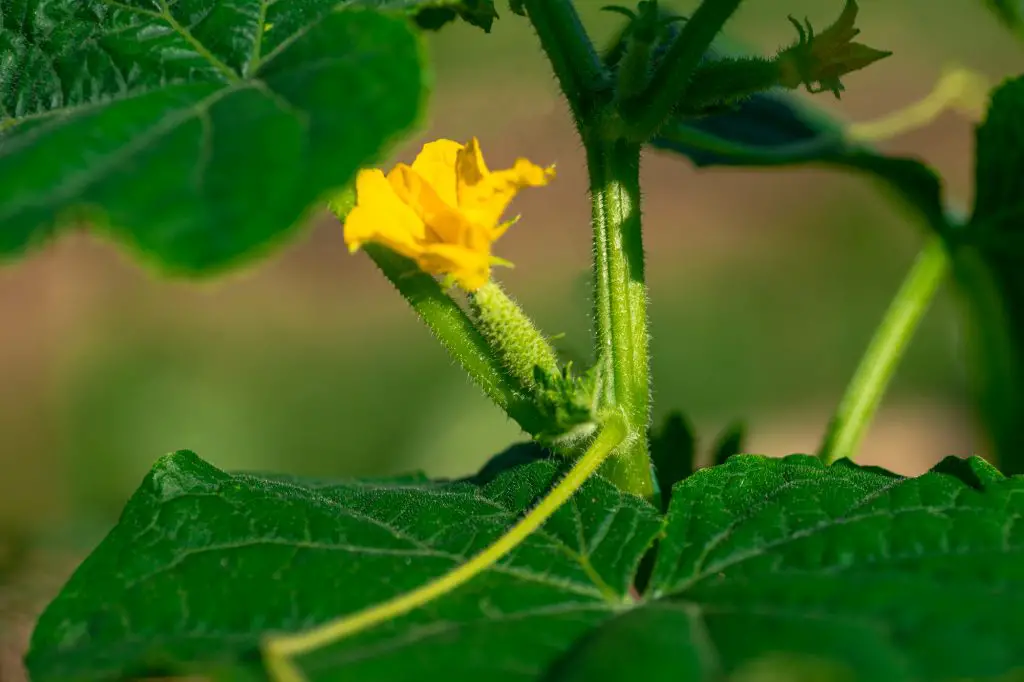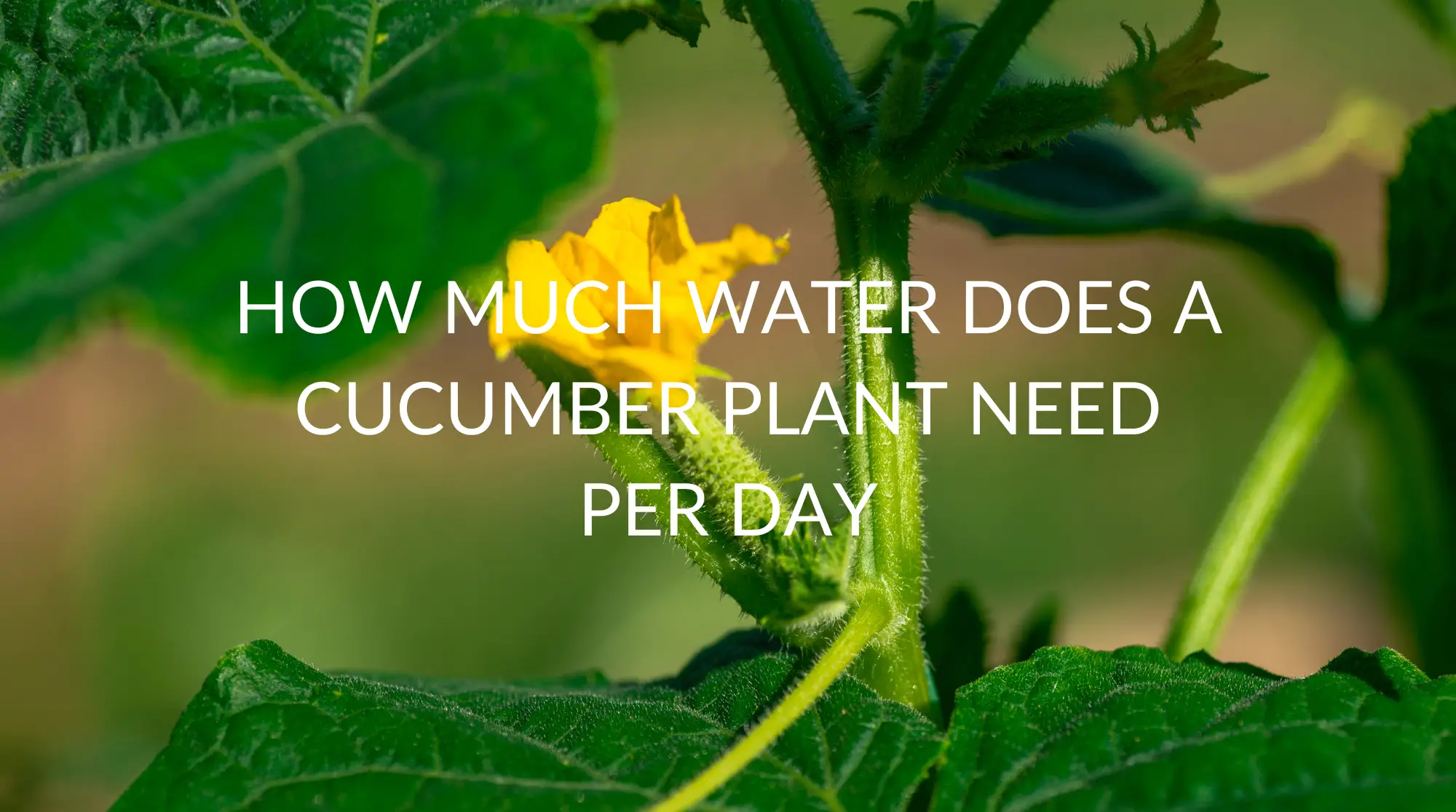Cucumbers, scientifically referred to as Cucumis sativus, are related to watermelons, zucchini, and pumpkins. They grow on vines that sprawl across the ground and can grow around 9-12 inches. But do you know how much water a cucumber plant needs per day?
Cucumbers need consistent watering to be properly taken care of. They require at least two inches of watering per week for maximum health and production. If temperatures are high, they’ll need a bit more. The general rule many gardeners go by is ¼ to ½ gallon of water per plant, per watering. If you don’t water them enough, you’ll harvest bitter-tasting cucumbers or oddly shaped ones too.
Want to know even more about watering your cucumber plants? This article will tell you everything you need to know about proper watering methods and techniques to produce the best cucumbers (and step up your summer salad game.)
How Often Do You Water Cucumber Plants?
Cucumber plants are actually made up of nearly 95% water! This means they need a steady supply of water to produce as many cucumbers as possible. There are many different considerations to take into account when you are watering your cucumber plants. Improper watering can produce bad-tasting vegetables or kill the plant altogether.
Some important considerations include whether the plant is in a pot or on the ground. If you have your plant in a contained setting, the plant lacks natural sources of hydration from the earth; therefore, extra monitoring is necessary to ensure proper water levels. Cucumber plants are one of the first plants to dry out, whether it be in a garden or container setting. Their vines, stems, and foliage all begin to wilt quickly when water is in short supply.
Another factor is whether the plant is in direct sunlight or only partial sun exposure. The seasons of the year may determine these factors more than you think. In the fall, when the cucumber plant is more established and bloomed, the weather will be cooler with less sun exposure, so you may only need to water the cucumber plant once a week.
Another factor is the spacing of the cucumber plants. Plants that grow closer together will compete over water supply, so you’ll most likely have to water more frequently.
If you’re confused, then worry not. The general rule of thumb for understanding how often to water your cucumber plants is to check the top half-inch of soil for dampness. If it’s dried out, give the cucumber plant some water. If it’s still damp or a bit moist, then there’s no need to water the plant as yet. The general rule many gardeners go by is ¼ to ½ gallon of water per plant, per watering.
In this helpful video, a gardening expert explains the basics of watering your cucumber plant.

How Often Do You Water Cucumber Seedlings?
Cucumber seedlings require more attention than fully grown plants. Seedlings tend to grow in bunches; therefore, they require more water because they absorb moisture quickly. That’s why you need to monitor your seedlings often to ensure they flourish into healthier adult plants.
If you don’t have time to monitor them every day, it’s best to give seedlings 1-2 deep waterings per week, as this is a better option than frequent light waterings which might result in seedlings not getting enough water. Once again, this depends on whether you’ve planted them in a spot that dries easily and gets adequate sun.
Seedlings that are deprived of water or don’t receive constant watering will result in plants that have wilted leaves or even poorly developed root systems, and this will make them more susceptible to attacks from pests and disease in the future.
If you’re unsure, the best way to check for soil dampness is to monitor soil color. Light-colored soil will indicate a lack of moisture, while deeper tones suggest that the water hasn’t fully been absorbed as yet. This method will keep you from guessing whether your seedlings need more water.
Effects of Overwatering a Cucumber Plant
Overwatering a cucumber plant is common in both greenhouse and garden plants, but it is less likely amongst greenhouse kinds. Especially less experienced gardeners tend to overwater their plants or water them the same amount regardless of environmental factors, which should affect the amount of water you provide.
There are many effects and indications of an overwatered cucumber plant. Here are three (3) effects that are crucial to know about before you start your cucumber garden. This section will cover
- Mildew
- Leaf Yellowing / Leaves Falling Off
- Root Rot
Mildew
Powdery mildew can appear on cucumber leaves that receive too much overhead watering. This mildew will eventually turn the leaves yellow and wilted. Mildew on plants isn’t just a problem for the appearance of the plants, but when the healthy leaves wilt and fall off, the plant is vulnerable to harsh and unnecessary sun exposure. The good news is that you can make a DIY solution with just a few ingredients to combat the mildew build-up.
Leaf Yellowing / Leaves Falling Off
The most common sign of overwatering is leaf yellowing. Too much water will prevent nutrients from reaching the root of the cucumber plant, and leaf growth may become stunted or limp, and they’ll simply fall off. Simply reduce watering and check the base of the plant to make sure it’s not sitting in a pool of water. In this video, an expert gardener provides other tips on how to save wilting cucumber plants.
Root Rot
Root rot is the result of unmonitored leaf yellowing, and this is a serious consequence of overwatering. A plant root that sits in too much water for a prolonged period of time is susceptible to root rot and will expose the plant to a host of bacterial diseases. Adding simple materials like decomposing leaves or adding sand to the soil will improve water drainage and save the root if it’s detected early enough. However, this method might not work until the beginning of a new growing season, as drainage issues aren’t a very quick and easy fix.
Tips For Watering Your Cucumber Plant
Despite the numerous types of cucumber plants that exist, watering is the golden rule that applies to all. Six (6) vital watering tips are provided to help you make the best of your plant. These tips include:
- Water Temperature Matters
- Watering to Prevent Bitterness
- Optimal Watering Times
- Deep Watering
- Drip Irrigation
- Early Watering
- Watering According to External Factors
- Re-Potting If Necessary
- Watering in Well Fertilized Soil
Water Temperature Matters
Believe it or not, water temperature affects the root temperature, which will affect the overall health of the cucumber plant. The optimum temperature for roots to absorb water and nutrients is approximately 68°F. This ensures it still contains a lot of oxygen and the right amount of heat to trigger the necessary root mechanisms that are needed for growth.
Watering to Prevent Bitterness
Provide cucumbers with 1 to 1 1/2 inches of water each week and spread mulch around the plants to keep the soil moist, which will keep the fruit from becoming bitter.
Water at Optimal Times of the Day
The best time to water your plants is, you guessed it, in the early morning. The simple reason for this is that any excess water that may be accumulated at the root will evaporate throughout the day naturally by the sun. But beware, watering too close to the mid-day sun is also not advised. It’s advised not to water cucumbers when they are in the heat of direct sunlight because this can scorch their leaves.
If you live somewhere with humid evenings and decide to water your plants at night, you run the risk of too much moisture collecting at the leaf and root. This will leave the cucumber plant susceptible to fungal bacterias.
Deep Watering
Cucumber seedlings have a surprising depth of 1- 1 ½ inches, so deep watering is vital to reach the roots. Run water slowly onto the surface of the soil rather than spraying it hard to keep from dislodging the seeds. A proper hose nozzle will ensure equal water distribution. See the next tip for more irrigation help.
Drip Irrigation
To ensure the right flow of water to irrigate the plants, try an adjustable nozzle or a soaker hose. But if you want to go a step further to ensure your plants get equal amounts of water while you don’t waste excess water, then drip irrigation is the gold standard.
Early Watering
Don’t go underwater in the early stages. Cucumber plants have a pretty cool ability to produce a long taproot along with their branching roots, but this vital taproot system won’t grow unless seedlings are watered from the very early stages.
Water According to External Factors
Cucumber plants growing in sandy textured soil will absorb water much quicker than plants growing in humus-based soil, so make sure you water according to the various soil conditions because each soil type requires different watering techniques.
Repotting
If you find that your cucumber plant needs constant rewatering, you may want to consider re-potting the plant so that it has more soil to spread its roots in. This will ensure proper water absorption.
Water in Well Fertilized Soil
Sometimes, no matter how well you water your plants, they just might not seem to be growing. Make sure that you’re using well-fertilized soil to ensure your plants are receiving the right nutrients through watering. Soils that are nutrient-dense and well-drained are essential to complement good watering techniques.
In this gardening video, an expert shows the benefits of using clay soil and how to water it according to this type of soil profile.
Recap
Cucumber plants are a great way to add a delicious vegetable to your produce lineup, but they require close attention, especially when it comes to watering. After all, they require about double the amount of water than other common garden plants. From the seedling stage to the plant stage, as a gardener, you must consider factors like water consistency and soil absorbency as you care for your plant.
It’s best to start watering consistently and frequently in the early stages to ensure the growth of the vital root system that allows for the uptake of necessary nutrients. These cylindrical vegetables are delicious and, overall, very easy to maintain in a garden with just the right amount of watering and care. Hopefully, with these tips and tricks, you’re confident in your new or existing cucumber plant garden!







